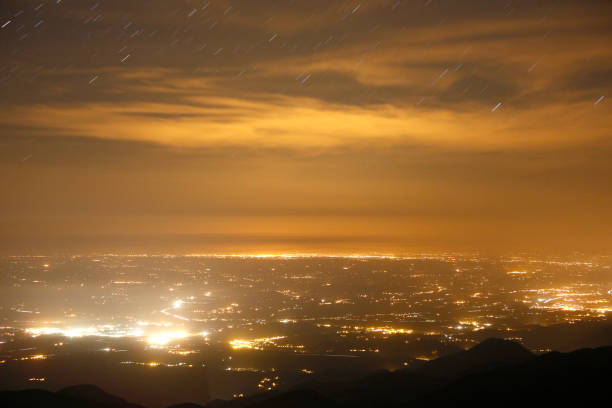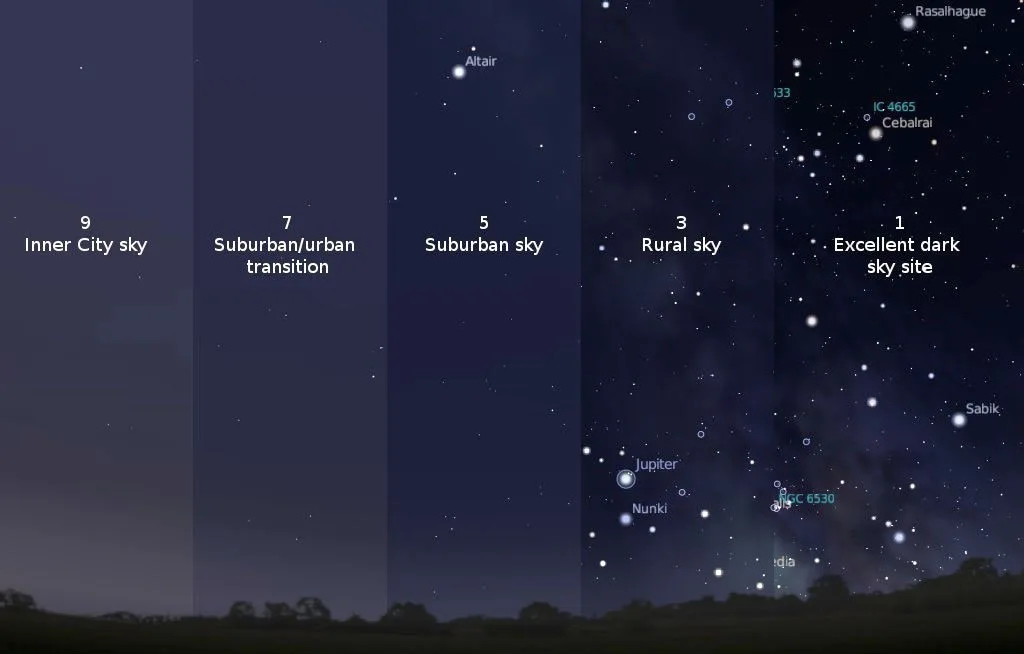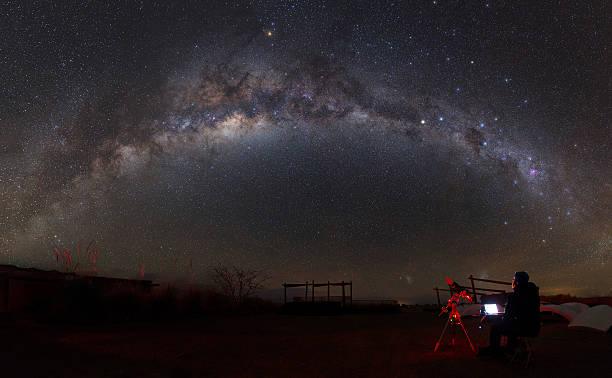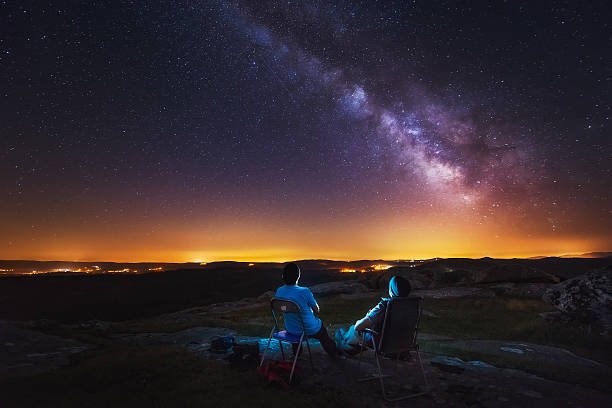Remember that childhood thrill of lying in the backyard, eyes wide with wonder, searching for shooting stars and whispering wishes to the twinkling expanse above? For me, that childhood fascination never faded. The city lights eventually encroached, dimming the celestial show, but the yearning for that cosmic connection persisted. It simmered beneath the surface, a quiet rebellion against the fluorescent hum of civilization.
One sweltering summer night, that embers of longing finally burst into flame. Fueled by exhaustion from late-night deadlines and a desperate need for something, anything, beyond the confines of my tiny apartment, I grabbed a blanket and drove. Hours later, I tumbled out of the car, blinking in the unfamiliar darkness of a remote mountain valley. There, sprawled across the velvety void, was a spectacle that stole my breath: a million pinpricks of light, a celestial tapestry woven with stories whispered across millennia.
In that moment, I wasn’t just staring at stars; I was staring into the face of infinity. The city lights, the deadlines, the anxieties – they all dissolved in the face of this humbling vastness. It was a baptism of starlight, a reminder of my place in the grand cosmic dance. And it was the spark that ignited my mission: to reconnect with the night sky, and to share that experience with others.
This wasn’t just about astronomy; it was about rediscovering the awe, the connection, the sheer magic that comes with gazing into the abyss. It was about reclaiming that childhood wonder, that sense of belonging to something bigger than ourselves. And through this guide, I want to be your cosmic cartographer, leading you to your own star-dusted epiphanies.
Demystifying the Night: Understanding Light Pollution and Its Impact

Imagine looking through a starry canvas and seeing only a faint glow. For many of us who live in areas with high levels of light pollution, this is regrettably the reality. Before we set out on our astronomical mission, however, it is crucial that we understand this challenging adversary: light pollution.
The Light That Steals the Stars
Light pollution refers to excessive or misdirected artificial light that intrudes into the night sky. Streetlights, billboards, even the warm glow from our windows, all contribute to this skyward illumination. While seemingly harmless, light pollution has far-reaching consequences, not just for astronomy, but for the environment and even our own health.
A Tale of Two Skies
To grasp the impact of light pollution, let’s compare two scenarios. Under a pristine, dark sky, our eyes can discern thousands of stars, many faint and elusive. The delicate glow of the Milky Way stretches across the heavens, a celestial river shimmering with billions of celestial bodies. It’s a breathtaking spectacle that speaks to the vastness and wonder of the universe.
Now, imagine the same scene under a light-polluted sky. The once vibrant darkness is replaced by a dull, orange haze. Stars, especially the fainter ones, disappear into the luminescence. The Milky Way shrinks into a faint wisp, its majestic tapestry shrouded in artificial light. This is the silent theft of our celestial heritage, a gradual dimming of the cosmos that many of us never even witness.
The Bortle Scale: Quantifying the Darkness

To understand the degree of light pollution in a particular location, astronomers use the Bortle Scale. This nine-point scale ranges from pristine Class 1 skies, where faintest stars and the ethereal Milky Way are readily visible, to heavily light-polluted Class 9 skies, where even bright stars struggle to pierce the artificial glow.
Understanding your Bortle class is crucial in planning your stargazing adventure. In heavily light-polluted areas, finding truly dark skies might require a bit of travel. However, even within city limits, seeking out pockets of darkness, like parks or rooftops with minimal artificial light, can significantly enhance your celestial viewing experience.
ALSO READ: Stargazing Like a Pro: Essential Tips and Gear for Amateur Astronomers
Your Celestial Toolkit: Essential Tools for Stargazing Success
With light pollution demystified, we’re now ready to dive into the exhilarating world of stargazing! But before you pack your bags and head out on your cosmic adventure, let’s equip you with the ultimate constellation compass: a toolkit brimming with resources to guide you to the best stargazing spots near you.
Mobile Apps: Your Pocket Planetarium
In this tech-driven era, our smartphones become powerful astronomical allies. User-friendly apps like Stellarium, SkySafari, and Sky Walk transform your phone into a real-time sky navigation system. Simply hold your phone skyward, and watch as constellations materialize, planets dance across the heavens, and satellites zip past.
Stellarium Mobile: This customizable app is a favorite among seasoned stargazers. It boasts detailed sky maps, astronomical phenomena predictions, and even telescope control capabilities for deeper exploration.
Sky Map: This classic app utilizes your phone’s location and orientation to overlay a real-time star chart on your screen. Simply hold your phone skyward, and watch as constellations materialize, planets dance across the heavens, and even satellites zip across the celestial canvas.
Star Walk 2: This visually stunning app offers a mesmerizing 3D rendering of the universe, allowing you to virtually explore galaxies, zoom in on planets, and even travel through time to witness the night sky at any point in history.
SkySafari: This visually stunning app offers a 3D rendering of the universe, allowing you to virtually explore galaxies, zoom in on planets, and even travel through time to witness the night sky at any point in history.
Traditional Treasures: Star Charts and Guidebooks
While apps offer instant gratification, there’s a certain charm to traditional star charts and guidebooks. These tangible companions encourage deeper learning and exploration, fostering a connection with the night sky beyond the digital screen.
Star charts: Portable and readily available, star charts provide detailed maps of constellations, making them ideal for learning celestial patterns and identifying specific objects.
Guidebooks: Packed with fascinating facts and historical anecdotes, guidebooks offer a more holistic understanding of the universe and its wonders. They can pique your curiosity about astronomical phenomena, inspiring further exploration.
Here are some examples of stargazing guidebooks for different levels of experience:
Beginners:
- National Geographic Backyard Guide to the Night Sky, 2nd Edition by Andrew Fazekas: This visually stunning book is packed with colorful maps, photos, and easy-to-understand explanations of the night sky. It’s perfect for families and those just starting to explore the stars.
- 50 Things To See With A Telescope – Kids: A Constellation Focused Approach by John Dobson: This interactive book encourages kids to explore the night sky with their own telescopes. It features constellation challenges, fun facts, and activities to keep them engaged.
- Turn Left at Orion: A Hundred Nightmares, a Bedtime Story, and a Journey Among the Stars by Guy Consolmagno: This charming book combines astronomy with mythology and storytelling, making it a delightful read for children and adults alike.
Intermediate:
- The Backyard Astronomer’s Guide by Terence Dickinson: This comprehensive guide covers everything from choosing the right telescope to observing planets, galaxies, and other celestial objects. It’s a great resource for anyone who wants to take their stargazing to the next level.
- The Cambridge Guide to the Constellations by Michael E. Bakich: This detailed book dives deep into the history, mythology, and scientific importance of the constellations. It’s perfect for stargazers who want to learn more about the stories behind the stars.
- NightWatch: A Practical Guide to the Universe by Terence Dickinson: This book provides a month-by-month guide to what to see in the night sky, along with tips for observing and photographing celestial objects. It’s a great resource for planning your stargazing adventures throughout the year.
Advanced:
- Peterson Field Guide to the Stars and Planets by Donald Menzel: This classic guidebook is known for its detailed star charts and concise descriptions of celestial objects. It’s a must-have for serious stargazers and amateur astronomers.
- The Constellations: A Field Guide for Stargazing by H.A. Rey and Martha Rey: This beautiful book features large, detailed constellation maps and engaging stories about the mythology behind each constellation. It’s a great resource for anyone who wants to learn more about the constellations in depth.
- Exploring the Night Sky: A Guide for Advanced Amateur Astronomers by Terence Dickinson and Alan Dyer: This comprehensive guide covers everything from astrophotography to spectroscopy, making it a great resource for experienced stargazers who want to learn more advanced techniques.
Remember, the best guidebook for you will depend on your level of experience and interests. So, browse through these suggestions and find one that sparks your curiosity and inspires you to explore the wonders of the night sky!
ALSO READ: How Astronomers Determine the Ages of Planets and Stars
Online Resources: Web-Based Wonders
The internet opens up a vast universe of astronomical resources. Websites like Stargazing.net and Astrocalendar keep you updated on upcoming celestial events like meteor showers, eclipses, and planetary alignments, so you can plan your stargazing adventures around these spectacular cosmic happenings.
Stargazing.net: This comprehensive website provides a wealth of information, from skywatching guides to event listings and astronomy news. It’s your one-stop shop for all things stargazing!
Astrocalendar: Never miss a celestial marvel with Astrocalendar! This website offers a detailed calendar of upcoming astronomical events, along with their visibility in different locations. Plan your stargazing getaways with precision!
Choosing the Right Tool for Your Stargazing Journey
No two stargazers are alike, so the ideal tool depends on your needs and preferences. Here’s a comparative table to help you navigate the celestial toolkit:
| Tool | Strengths | Limitations |
|---|---|---|
| Mobile Apps | Real-time sky navigation, user-friendly interface, convenient accessibility | May require internet connection, battery drain, limited in-depth information |
| Traditional Star Charts | Portable, affordable, encourages independent learning, fosters deeper connection with the night sky | Relies on user interpretation, limited information, may require additional resources |
| Guidebooks | Rich in information, historical context, and fascinating facts | Can be bulky, not ideal for real-time sky navigation, may not always be updated |
| Online Resources | Comprehensive information, event listings, up-to-date celestial happenings | Requires internet connection, may lack in-depth details, impersonal experience |
Remember, the best tool is the one that sparks your curiosity and ignites your passion for the night sky. So, mix and match, experiment, and above all, embrace the wonder!
Key Factors for Choosing a Location For Stargazing

With your celestial toolkit prepped, it’s time to set the stage for your stargazing adventure! But unlike a movie theater with dimmed lights and comfy seats, choosing the perfect stargazing location requires a bit more thought. Fear not, aspiring cosmic travelers! This section will break down the key factors to consider, transforming you into a location-savvy stargazer in no time.
Dimming the City Lights: Battling the Blight of Light Pollution
Light pollution, that arch-nemesis of starry skies, is our first hurdle. As mentioned earlier, the Bortle Scale serves as our darkness decoder ring. Ideally, you’d aim for a Class 1 or 2 sky, where thousands of stars blaze and the Milky Way unfolds its ethereal ribbon.
But don’t despair if you’re city-bound! Even within urban jungles, pockets of darkness exist. Parks, rooftops with minimal lighting, and even secluded corners of your backyard can offer surprisingly decent views. Every mile you put between yourself and city lights makes a big difference. Remember, even a Class 3 or 4 sky can reveal constellations and planets, offering a taste of the celestial wonder that awaits beyond the urban glow.
Reaching for the Stars: Altitude Matters
Think of it as climbing a cosmic ladder: the higher you go, the closer you get to the stars! Ascending mountains or hills reduces the haze and dust that dims the sky, especially if you’re escaping the clutches of light pollution. Even moderate elevation changes can significantly improve your stargazing experience.
Additionally, higher altitudes often enjoy clear, dry air, perfect for unobstructed celestial viewing. So, if you’re planning a camping trip or find yourself near a hilltop, consider taking your stargazing experience to new heights. Remember, though, proper clothing and safety precautions are crucial if venturing to higher grounds.
Weathering the Cosmic Storm: Moon and Clouds Play Hide-and-Seek
The moon, our celestial neighbor, can be both friend and foe to stargazers. During its full phase, its silvery glow washes out fainter stars. Aim for new moon nights, when darkness reigns supreme, or periods when the moon is in its waning or waxing crescent phases.
As for clouds, they act like celestial curtains, sometimes shrouding the cosmic show. Check weather forecasts beforehand and keep an eye on cloud patterns. Remember, even fleeting breaks in the cloud cover can offer amazing glimpses of the starry abyss. Patience and flexibility are key, for sometimes the most unexpected moments reveal the most breathtaking cosmic surprises.
Safety First: Cosmic Adventures with Common Sense
Always prioritize your safety and well-being. Let others know about your stargazing plans, choose well-lit paths if venturing out at night, and avoid isolated areas. Consider packing insect repellent, warm clothing, and a flashlight. Remember, respecting the environment and leaving no trace are essential parts of your cosmic journey.
With these key factors in mind, you’re now equipped to choose the perfect location for your stargazing adventure. In the next section, we’ll unveil hidden gems near you, from pristine dark sky reserves to urban oases of darkness, ready to transform your stargazing dreams into reality!
ALSO READ: The moon by many names: Exploring moon names from different cultures
Unveiling Hidden Gems: Stargazing Havens Near You
The stage is set, you’re armed with cosmic knowledge, and now it’s time to unveil the most dazzling part: secret stargazing spots near you! Whether you’re nestled in a bustling city or surrounded by sprawling fields, hidden pockets of starry wonder await.
Urban Oases: Diamonds in the Rough
Don’t let city lights fool you! Even within the concrete jungle, pockets of darkness glimmer like celestial oases. Parks, botanical gardens, rooftops with minimal lighting, and even secluded corners of your backyard can offer surprisingly decent views. Look for areas shielded from streetlights and buildings, where the sky peeks through like a cosmic canvas.
Dark Sky Reserves: Where Stars Unfurl Like a Cosmic Tapestry
For those seeking the ultimate darkness, designated Dark Sky Reserves beckon like celestial sanctuaries. These protected areas, far from urban glow, preserve the night sky in its pristine glory. Imagine thousands of stars blazing, the Milky Way swirling like a celestial river, and planets shimmering like distant jewels.
Look for Dark Sky Reserves near you, or plan a getaway to one of these starry havens. Experience the wonder of a truly dark sky, where constellations come alive and the universe unfolds its majestic tapestry. Don’t forget to research park rules and etiquette before embarking on your dark sky adventure.
National Parks and Natural Wonders: Nature’s Celestial Theatre
Nature’s own amphitheaters, national parks and other natural wonders offer breathtaking backdrops for your stargazing adventures. Escape the city lights and immerse yourself in the whispering of leaves and the chorus of crickets. Mountain ranges offer spectacular views, while vast plains create a sense of cosmic intimacy.
Research which national parks are known for their clear skies and minimal light pollution. Imagine gazing at the Milky Way from atop a mountain peak, or spotting shooting stars from a moonlit meadow. These natural cathedrals of darkness inspire awe and remind us of our place in the grand cosmic dance.
Local Gems: Uncovering Hidden Treasures in Your Backyard
Sometimes, the most breathtaking stargazing experiences are closer than you think. Explore your own neighborhood, seeking out parks, fields, or even quiet corners of your own backyard. Every location offers a unique perspective on the night sky. You might be surprised by the hidden gems waiting to be discovered right under your own starry canvas.
Remember, even a partially dark sky can reveal wonders. So, grab your family, friends, or simply yourself, and embark on a celestial exploration of your own backyard. You might just discover a secret stargazing haven right near your doorstep.
ALSO READ: What would signal life on another planet?
Essential Tips and Tricks for an Unforgettable Journey

With your cosmic destination chosen, it’s time to polish your stargazing skills and pack the perfect toolkit for an unforgettable night under the sky. Remember, preparation is key to maximizing your celestial experience, transforming you from a passive observer to an active participant in the wonder of the universe.
Layering for the Cosmic Show
The night sky might be breathtaking, but the temperature can dip just as quickly. Dress in comfortable layers, adjusting for the specific climate and time of year. A warm hat, gloves, and a cozy blanket are your celestial companions, ensuring you stay comfortable without hindering your stargazing. Remember, a chilled body distracts from the cosmic beauty!
Eyes Adjusted, Wonders Revealed
Give your eyes time to adjust to the darkness! Avoid bright lights or screens for at least 30 minutes before stepping outside. This allows your pupils to dilate, maximizing your ability to see faint stars and the ethereal glow of the Milky Way. Patience is key, for as your eyes adjust, the universe will slowly reveal its hidden treasures.
Tools for the Trade: Light Pollution Busters and Celestial Comforts
A red headlamp or flashlight helps you navigate without disrupting your night vision. Choose red light options, as white light throws your eyes back into darkness mode. Consider packing a star chart or app to identify constellations and celestial bodies, turning strangers in the sky into familiar friends. A comfortable reclining chair or even a picnic blanket can elevate your stargazing experience, transforming stargazing into a luxurious cosmic lounge.
Beyond the Gear: Mindful Gazing and Cosmic Etiquette
Remember, stargazing is a sensory experience. Disconnect from your phone and other distractions, letting your eyes, ears, and even your sense of smell immerse you in the symphony of the night. Listen to the rustle of leaves, the chirping of crickets, and the distant murmurs of nature. Embrace the silence, for it speaks volumes about the universe around you.
Finally, respect the night sky and your fellow stargazers. Avoid using bright lights that might disrupt others’ viewing. Leave no trace behind, ensuring future generations can enjoy the same starry wonder.
With these tips tucked away, you’re ready to embark on a stargazing adventure filled with wonder, knowledge, and perhaps even a sprinkle of cosmic magic. So, step outside, adjust your eyes, and let the universe unfold its breathtaking story before you. The stars await, eager to share their secrets with you.
ALSO READ: Astronomical Discovery: Star Engulfs Planet in First-Ever Observation
Answering Common Stargazing Questions
How do you start stargazing?
To kickstart your stargazing adventure, embrace the darkness! Escape city lights, aiming for moonless nights or nights with crescent moons. Early evenings work, but for the Milky Way, later hours are your friend. Let your eyes adjust to the dimness, avoiding bright screens beforehand. And don’t worry about fancy equipment – start simple! Look for familiar constellations like Orion or Ursa Major, perhaps with the help of a star chart or app.
When is Best Time to Stargaze?
Think darkness, seasonality, and late nights. Ditch the moonlit nights and aim for new moon phases or crescent moons. Spring and fall offer long, clear nights, while winter can be stunning (but chilly!). Wait a few hours after sunset for your eyes to adjust, especially if you’re chasing the Milky Way later in the night.
How Can I See the Milky Way?
Escape the city lights! Dark Sky Reserves are your best bet, but even a park away from streetlights can make a difference. Adjust your eyes: avoid bright screens for at least 30 minutes before gazing. Look for the Milky Way in summer, stretching across the sky from Sagittarius to Cygnus. Consult star charts or apps to find your way.
How To Take Photographs Of the Night Sky?
Gear up with a DSLR: smartphones struggle with low light. A tripod is your steady friend, and manual focus is key in the darkness. Experiment with settings: play with shutter speed, aperture, and ISO to find the perfect balance. Embrace editing: reduce noise, adjust contrast, and enhance details for celestial masterpieces.
Remember: Patience, practice, and enjoying the starry wonder are essential ingredients. Don’t hesitate to ask me anything else in the comment section below! Your cosmic guide is always here to help you navigate the wonders of the night sky.
Final Thoughts
And so, our cosmic odyssey draws to a close. We’ve journeyed through the essential tools, hidden havens, and deep knowledge pathways that unlock the magic of stargazing. Remember, your journey doesn’t end here. Step outside, armed with your newfound toolkit, and let the night sky reveal its breathtaking secrets. Seek out those pockets of darkness, where constellations come alive and distant galaxies shimmer like celestial jewels. Use apps and charts to navigate the cosmic canvas, but don’t forget to simply gaze in awe, letting the universe whisper its stories to you.
Embrace the learning journey! Delve deeper into celestial objects, planets that dance amidst constellations, and galaxies swirling millions of light-years away. Share your wonder with others, join fellow explorers, and contribute to protecting this precious night sky for future generations. The wonders of the cosmos await!
